We all know that working too much is bad for our long-term productivity and overall health.
However, we also know that we sometimes have to work longer than usual.
Reasons for this can vary:
- You’re approaching a deadline or you’re close to crunch time.
- You’re covering for your teammate who has been sick for a while.
- You’re preparing an important presentation for a conference next week.
- You’re transitioning into a new position — you are being a mentor to the person who is replacing you and you’re being trained for the new position you’re going to fill.
- You’re trying to get that promotion and you want to show your boss you’re up for the challenge.
Whatever your motive is, you should be ready to manage working 80+ hours a week when necessary.
In this blog post, we’ll cover some strategies you can use to help you pull off working 80+ hours per week successfully, while also staying healthy.
Plus, we’ll mention some famous people who currently work or have worked 80+ hours a week in the past — their examples can serve as inspiration.
In the end, we’ll offer an example of what your 80+ workweek can look like and some additional tips to help you with that.
Read on.
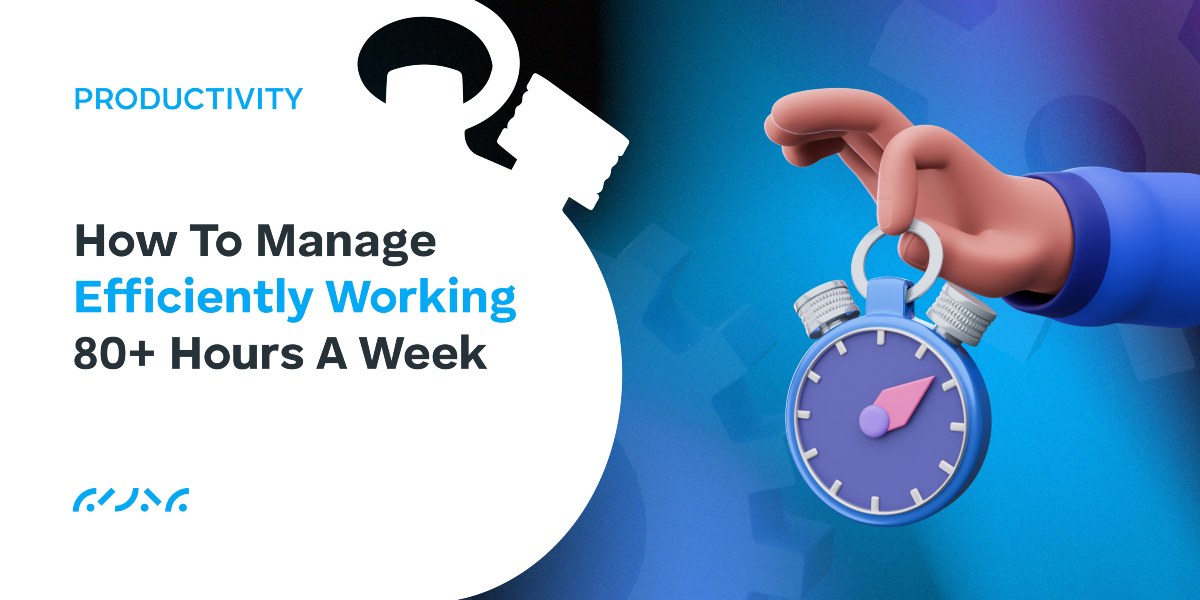
Table of Contents
Famous people who work long hours
Although the standard workweek usually counts 40 hours, some people put in much more than that.
Namely, a number of successful people are famous for putting in long hours every week. Let’s see how they do it and why.
Elon Musk — Founder, CEO, and chief engineer of SpaceX
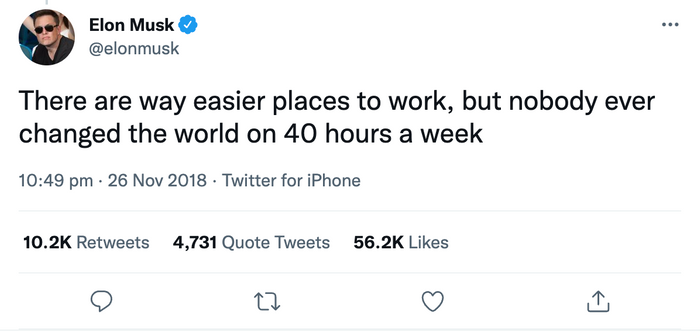
Elon Musk’s tweet on working 40 hours a week
Musk is a firm believer in hard work. He thinks that people need to work about 80 hours a week to change the world.
His time management routine involves a time blocking technique and working 120 hours per week.
Indra Nooyi — Former CEO of PepsiCo and Supervisory Board Member at Phillips
Although she stepped down as PepsiCo CEO over 4 years ago, Nooyi is still famed for getting up at 4 a.m. and having worked 18 to 20 hours a day for 40 years.
She used to focus most of her day on work — she’d work until midnight every day.
Jeff Bezos — Executive chairman of Amazon and founder of Blue Origin
Bezos is famed for getting up early, too. He always sets his most important meetings for the morning and starts with the first one at 10 a.m.
During his first days at Amazon, Bezos used to spend 12 hours a day working.
Marissa Mayer — Former CEO of Yahoo and co-founder of Sunshine Contacts
Mayer claimed to have worked 130 hours per week during her time as CEO.
She’s famous for having worked from her hospital bed soon after giving birth to twins in 2015.
Former Yahoo director Max Levchin calls her “the hardest working CEO in Silicon Valley, bar none.”
—
The workweek of Mayer, Bezos, Nooyi, and Musk seems packed, yet these entrepreneurs manage to helm successful companies and still lead a life with their spouses and children.
So how do they do it?
The math behind the 80+ hours equation
There are 168 hours in a week. That’s 24 hours per 7 days you have at your disposal.
Let’s take a look at some basic math to see how much time you would have if you worked 80 hours a week, 100 hours a week, or 120 hours a week.
🔷 Example #1: Working 80 hours a week
If you work for at least 80 hours per week, you have 88 hours for other, non-work-related activities.
You will have roughly 12,5 hours of free time every day.
If you aim to sleep at least 7 hours per day, you are left with 5,5 hours for other activities: meals, socializing, hobbies, and other.
The more you work, the less free time you’ll have per day.
🔷 Example #2: Working 100 hours a week
If you work 100 hours per week, you’ll have about 68 hours for non-work activities.
This amounts to a little more than 9,5 hours of free time per day.
Working 100 hours a week means you will be able to sleep about 6 hours every day and spend the rest of your time engaged in meals, hobbies, socializing, etc.
🔷 Example #3: Working 120 hours a week
If you work 120 hours per week, you’ll have 48 hours for free-time activities.
This translates to about 7 hours of leisure time and 5 hours of sleep daily.
—
The raw numbers say that working at least 80 hours per week is a manageable feat — but, the likelihood decreases as the number of working hours increases.

💡Clockify Pro Tip
If you notice that you’re having problems with sleeping or notice significant changes in your behavior, you might be experiencing mental fatigue. What it is and how to overcome it read here:
Staying healthy in an 80+ hour work routine
Putting in long hours every day almost guarantees overwork and burnout — so, it’s vital that you take care of your health.
Make sure you always leave enough time for meals and sleep — they are your biggest allies in staying productive, considering you cannot properly work when hungry, or sleep-deprived.
So, to stay healthy and still manage to cram 80+ hours of quality work into one week, you should take your free time to:
- Eat healthily and regularly.
- Get enough quality sleep.
- Keep in mind your priorities.
- Remember what your goals are.
- Make a daily schedule and stick to it.
- Take regular breaks.
- Enjoy your leisure time to the fullest.
Let’s see how you can achieve all this.
➡️ Eat healthily and regularly
When you work 80+ hours a week, you’re unlikely to have enough time for cooking. The best you can do is:
- Prepare your meals in advance: Cooking each day is time-consuming, so it’s best that you batch cook, and freeze leftover food for the other days of the week. Just make sure it’s all properly packed and stored in your freezer.
- Opt for healthy snacks: These are handy when you get hungry, but don’t want to leave your desk. Low carbs, such as nuts, are a great choice, but you can also try almonds and grapefruits — they‘ll help you feel full longer, so you’ll be able to work longer.
- Order everything you can online: When you’re pressed for time and can’t even go grocery shopping, order your groceries and other supplies online. Many stores allow you to do that at an affordable price.
- Stay hydrated throughout the day: Drink a glass of water as soon as you wake up. When you feel a dip in your energy, drink a glass of water, and you’ll feel instantly refreshed. Aim for at least 8 cups of water a day.
💡 Clockify Pro Tip
If you want to achieve more with your everyday meals and boost your productivity with food, you should make sure to include some superfoods in your diet. Check out our guide to get started:
➡️ Get enough quality sleep
Nothing can replace a good night’s sleep. It’s your most important non-work activity.
Just imagine what it would feel like to work when drowsy — would you be able to concentrate and do your best work?
When you have to work 80+ hours a week, quality sleep and power napping are your best ally.
Making the most of your sleep includes:
- Sleeping or napping in your bed: Avoid napping in your chair or sofa whenever possible. Quality sleep and power napping make sense only if they make you feel good afterward.
- Having a night routine: Try some unwinding activities before going to bed to make it easier to fall asleep. You can read a book, drink a glass of warm milk or tea, or play some soothing music. It’s entirely up to you.
- Not sleeping in your office and not working in your bed: Work is work and sleep is sleep — don’t combine the two. If you have to stay late at the office, make sure to have a ride home when you’re done and sleep in your comfy bed. And, if you work from home, don’t bring your work to bed — do it in your home office only.
- Not consuming certain foods and substances before bed: In the evenings, avoid foods and substances that will make falling asleep more difficult — for example, caffeine and nicotine are known to keep you up longer even if you don’t want to.
- Avoiding alcohol before bed: The same goes for alcohol — it blocks you from entering the REM phase of your sleep, which is a vital phase for your rest.
➡️ Keep in mind your priorities
Having a packed week means you’ll rarely have time or be in the mood to tackle additional tasks.
So, making sure you dedicate the majority of your time to the right tasks is essential — you simply have to know what your priorities are.
Let’s look at an example:
- You have 10 bugs in your program. It’s an urgent matter you have to deal with but it’s likely to take away a lot of your time.
- Out of the 10, you have 8 bugs you can easily fix.
- You also have 2 demanding bugs that, if solved, would get rid of 80% of your program’s problems.
- Of course, you would love to cross out 8 bugs from your list. It sounds encouraging to achieve outstanding progress by crossing off 8 items on your to-do list at the end of the day.
- But, you’re also aware that it’s best to tackle the 2 more difficult and more meaningful bugs first.
This approach to observing priorities is based on the Pareto principle, defined in the 19th century by the Italian economist and sociologist, Vilfredo Pareto.
In productivity, the Pareto principle proposes that 20% of the right efforts bring 80% of your results.
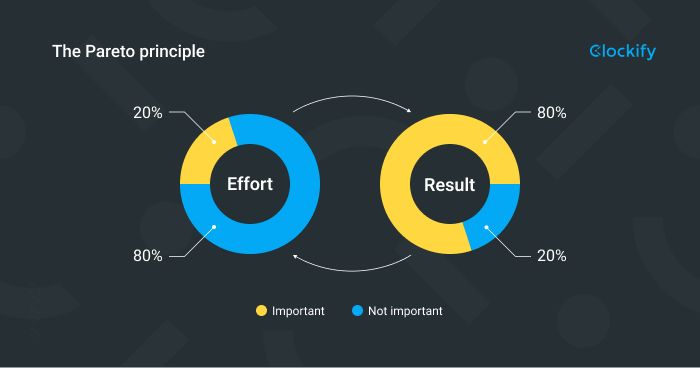
What does this actually mean for your bug problem?
Well, once you’re done with the 2 most difficult bugs you’ll likely improve your program by 80%. Later on, it’ll be no problem to tackle the 8 remaining, easy bugs.
The same is true for any other type of task — do the 20% of tasks that represent your priorities and enjoy as much as 80% of the expected success.
➡️ Remember what your goals are
It’s vital that you consider your main goals, and why you’re dedicating 80+ hours to your work.
Are you working hard in order to promote your business to the right people?
Is your plan to work more now and work less later on in life?
Are you working two jobs to save money for school?
Whatever your goal may be, having it in mind is more than sufficient to motivate you to keep going – just make sure you’re aiming at the right goal.
One important lesson in keeping true to your goals is learning to say “No” to projects and tasks that have no real value for you. They’ll only take away from the time you could be focusing on more important, goal-oriented activities.
💡 Clockify Pro Tip
To be sure you’re doing it right, you can track the time you spend on your goals and track your goal progress. You can do this with our free goal tracker app:
➡️ Make a daily schedule and stick to it
It’s important that you create a straightforward schedule for your workdays, and stick to it — if you have everything written on paper, you likely won’t stray away from your target hours.
Make sure to create to-do lists, identify your priorities among the to-do list items, and block specific times of day for them — set general or specific goals you’ll want to accomplish with a task or a group of tasks.
The difference between a schedule for a regular work week, and a workweek that lasts at least 80 hours, is that you should aim to schedule everything:
- Your most important work assignments
- Your accompanying tasks
- Your meals
- Your time off with friends and family
- Your workouts
- Your bedtime
- Miscellaneous other activities
Keeping to the math is crucial with a busy work week because it’s the only way for you to stay on track.
💡 Clockify Pro Tip
Making a daily schedule can be fun and fulfilling. Check out our guide to help you with that. There are some cool templates, too:
➡️ Take regular breaks
Short breaks help you charge your batteries.
Make it a habit to implement breaks during your work routine.
If you’ve already re-filled your cup of coffee during break 1 and went to the bathroom during break 2, you can use break 3 to plan the leisure time you’ll have during the week.
Remember, when working more than 80 hours a week, incorporating breaks is simply a must.
➡️ Enjoy your leisure time to the fullest
You should spend more time on your leisure activities than you do on regular in-between-work breaks. And, in regards to that, your reward activities should last longer, and be more elaborate — you work a lot, so you deserve some quality downtime.
These free time activities can be anything you enjoy:
- A long walk
- Spending time in nature
- A dinner out with your family
- Going out to catch the latest 3D installment with your friends
- Going to a football or basketball match
- Listening to your favorite music
This time should be free from work. Use it to unwind and don’t think about your projects, or the work that awaits you tomorrow.
🔷 An example of a daily schedule in your 80-hour workweek
So, you have a deadline for a project closing in and you want to work 80 hours within a week. It’s the only way to finish everything on time.
Even if you’re planning to work for 12 hours for the next seven days, bear in mind that not all the work you’ll do will be a priority. You’ll likely spend a certain amount of time on priority tasks and a certain amount of time on accompanying tasks.
Here is an example of a 24-hours breakdown, for a 12-ish hour workday, grouped by time of day — morning, afternoon, and evening:
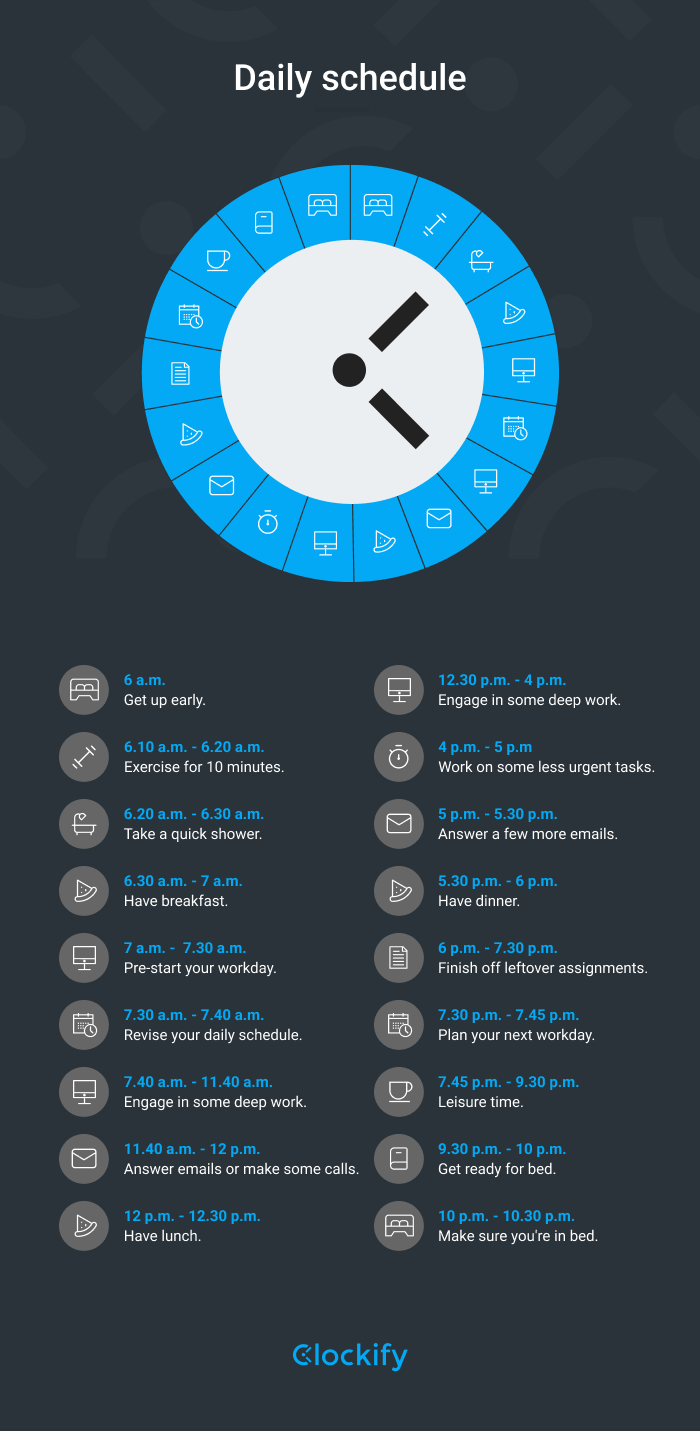
🕖 Morning activities
🔷 6 a.m. — Get up early.
Getting up early will help you get a head start on your day.
🔷 6.10 a.m. – 6.20 a.m. — Exercise for 10 minutes.
Exercising will help you ease into the day refreshed and alert.
🔷 6.20 a.m. – 6.30 a.m. — Take a quick shower.
Taking a quick and cold shower (ouch!) will make sure you’re fully awake.
🔷 6.30 a.m. – 7 a.m. — Have breakfast.
Having breakfast is essential for boosting your energy. You can prepare your breakfast the night before or opt for a quick and nutritious meal in the morning.
🔷 7 a.m. – 7.30 a.m. — Pre-start your workday.
If you commute to work, use this time to answer some emails or go through some client contracts and proposals.
If you work from home, make some coffee or tea.
🔷 7.30 a.m. – 7.40 a.m. — Revise your daily schedule.
Going through your schedule and considering your priorities can help you prepare mentally for your busy day.
🔷 7.40 a.m. – 11.40 a.m. — Engage in some deep work.
Engaging in deep work will allow you to spend 3-4 hours of pure, uninterrupted work time.
You can parse a complex task into subtasks and allocate enough time to complete each subtask.
You should track the time you spend on these sub-tasks because it can boost your productivity.
🔷 11.40 a.m. – 12 p.m — Answer emails or make some calls.
Answer some more important work emails or conduct some client calls. These activities are great for you to ease out of your “zone” before lunch.
🕧 Afternoon activities
🔷 12 p.m. – 12.30 p.m. — Have lunch.
To save time and still enjoy your lunch, you can order in or eat a pre-prepared lunch.
🔷 12.30 p.m. – 4 p.m. — Engage in some deep work.
Use this time to focus on your most important tasks and assignments. You can make this time block less about pure work and implement longer breaks.
Science shows that our brains experience 90 minutes of high-frequency activities, followed by 20 minutes of low-frequency activities.
So, you can work for 90 minutes and then rest for 20.
Or you can also try out the famed Pomodoro technique which is based on 25/5 cycles — you work for 25 minutes and take breaks for 5 minutes.
💡 Clockify Pro Tip
If you’re already using Clockify, you can enhance your Pomodoro experience with Clockify’s extensions for Chrome and Firefox. They can notify you when your break is over and you can go back to work. Access them all here:
🔷 4 p.m. – 5 p.m. — Work on some less urgent tasks.
Depending on what you usually do, you can work on less urgent but still vital tasks:
- Call up a team brainstorming session.
- Attend a meeting.
- Schedule an international conference call.
🔷 5 p.m. – 5.30 p.m. — Answer a few more emails.
Whether you’re commuting or not, you can check your inbox again, order some groceries and supplies, or even better — take a quick nap.
🔷 5.30 p.m. – 6 p.m. — Have dinner.
Having dinner will give you that final boost of energy and help you finish whatever tasks you have left for today.
🕗 Evening activities
🔷 6 p.m. – 7.30 p.m. — Finish off leftover assignments.
You can use this hour and a half to finish leftover assignments — be it planning for a launch event or going through your business goals for the next quarter.
🔷 7.30 p.m. – 7.45 p.m. — Plan your next workday.
Planning your workday for tomorrow can start with writing a to-do list and putting priority tasks at the top of your list.
You can also create a template schedule and fill it out each day. This template should account for:
- Your morning routine.
- All your meals.
- All your work-related activities: your conference calls, meetings, and other client-related activities.
- Leisure time.
- Time for unexpected activities.
🔷 7.45 p.m. – 9.30 p.m. — Leisure time.
Time reserved for relaxing is meant to help you unwind from work, as well as socialize with friends and family. You can go out for a quick drink, watch a movie, or simply chat with loved ones.
🔷 9.30 p.m. – 10 p.m. — Get ready for bed.
Getting ready for bed should also be a routine time for you — take a shower, read a chapter of your favorite book in bed, or listen to some soothing music — some of it will help you fall asleep faster.
🔷 10 p.m. – 10.30 p.m. — Make sure you’re in bed.
If you go to bed around this time, you’ll get between 7–8 hours of sleep until it’s time to wake up at 6 a.m. tomorrow.
🏷️ The analysis of this 80+ workweek example schedule
This schedule shows that you’ve spent:
- About 7,5 hours on deep work activities.
- Almost 4 hours on accompanying activities.
- And about 25 minutes on polishing your schedule.
Although that’s not something you’d expect from a strenuous workday, you’ve also managed to
- Work out.
- Eat three meals per day (including the often-skipped breakfast).
- Go to bed at a reasonable time to get 7–8 hours of sleep.
- Spend some leisure time with family and friends, or maybe even on a hobby.
In conclusion — you’ve gone through a significant amount of work, and you’ve managed to stay healthy while doing it.
Additional tips that can help you work 80+ hours a week effectively
Although eating right, sleeping enough, and practicing your deep work capabilities are the crucial elements to consider for long workweeks, there are extra tips that can help you along the way.
💡 Clockify Pro Tip
If you still feel like you’re not getting things done, you’ll have to work smarter, not harder. Take a look at our text for more information:
👉 Don’t forget yourself in your work
You’re probably familiar with this famous saying: “If it’s fun, it’s not work.”
But, if you’re someone who truly loves their job — you most certainly know what it means to lose yourself in work.
You’ve probably invested your whole self into what you do, which makes you put in more effort and more hours.
You’re probably a perfectionist and a high-achiever, too.
This can make you lose track of time and spend much more of it on work, especially if you’re enjoying it immensely.
But, don’t forget to take a breather from time to time.
👉 Set timers for most of your activities
If you’ve already planned out your day or week, setting timers and alarms might be a smart move for you.
This will help you stay on track — you won’t get carried away by just one type of activity.
If you’re not tracking your time yet, you can try out a time tracking app, such as Clockify.
In addition to providing you with a bunch of other useful features, such as a free time clock app you can use as a timer, Clockify’s calendar and scheduling features can come in handy when you’re planning your next 80-hour workweek.
Also, Clockify comes as a part of a productivity suite, so if you’d like to make the most out of your time while working long hours, you may want to consider pairing it up with a task management and a team communication app.
👉 Take advantage of long commutes
If you’re commuting to work and you didn’t have time to work out today, take a walk to work/home instead of riding a bus or taxi.
Besides being beneficial for your physical health, walking can:
- Increase your energy levels.
- Reduce stress and tension.
- Boost your mood, cognition, memory, and sleep.
- Improve your balance and coordination.
You can even make it into a routine — pick one day in the week when you’ll walk home or to work and stick to it.
👉 Prioritize socialization
When you’re working 80+ hours a week, socializing might be the last thing on your mind.
But, you might be making a mistake here.
According to Angela K. Troyer Ph.D., an expert on perception, cognition, and cognitive neuroscience, socializing provides a number of benefits to our physical and mental health.
In one Psychology Today article, she lists four of those benefits:
- We may live longer.
- We will likely enjoy better physical health.
- We will also enjoy better mental health.
- And, according to recent research, we might even lower our risk of dementia.
All in all, if you hang out regularly with your family and friends, handling an 80-hour workweek might not be so stressful.
👉 Move around whenever possible
With the spread of remote and hybrid work, many of us have gotten pretty comfortable working from home.
But, many of us have also gotten lazy and completely forgotten to work out.
Could you imagine yourself sitting for 80 hours in one week?
According to the latest federal research conducted by the CDC, 1 in 4 Americans sits for more than 8 hours a day.
You might not be aware of it but the sitting disease has become one of the major problems globally, regardless of the place of work. Moreover, too much sitting has been proven to affect our metabolic health.
So, to avoid major health issues, especially if you don’t have a standing desk, make the effort to move as often as possible — even for a few minutes. You can:
- Sit while writing a project proposal but walk around while taking a phone call.
- Take a quick walk to the kitchen to grab another glass of water or a snack.
- Do some light exercise for your neck and back while sitting.
- Stretch your legs every hour or two.
- Use your breaks to take your garbage out and breathe some fresh air.
- Set a timer to remind you to get up from your chair several times a day.
👉 Ask for help
For some of us, working 80 hours a week is inevitable. At least it was for me at some point in my career and life.
When this is the case, asking for help with the littlest things is something you should get used to.
Your family and your closest friends have got your back. Don’t hesitate to reach out if you’re feeling like you’re stretched too thin.
If someone else can pick up your kids from school or buy you some groceries after work, why not ask them?
Remember, not all superheroes wear capes. Some of them are working 80+ hours per week.
💡Clockify Pro Tip
Although it’s perfectly fine to put in overtime work for short periods of time, making this a habit is not sustainable in the long run as it leads to serious health and work issues. Check out our blog post about career burnout to learn how it affects our health:
Master your 80-hour workweek — with Clockify’s integrations
If you live on planet Earth in the 21st century, you probably use more than one tool for work.
But how much time does all of that back-and-forth cap your productivity?
Chances are: A lot!
To eliminate workflow interruptions and stop switching from one tool to another, use productivity tracking software like Clockify.
With this app, you can easily track how much time you spend on all your tasks. The integrations supercharge your efficiency by connecting your Clockify account to many project management, task software, and collaboration tools, including:
- JIRA,
- Pumble,
- ClickUp,
- Plaky,
- QuickBooks,
- Google Calendar, and more.
Below, you’ll see an example of tracking your work time in Asana. If you click on the Clockify icon, the app instantly records your time.
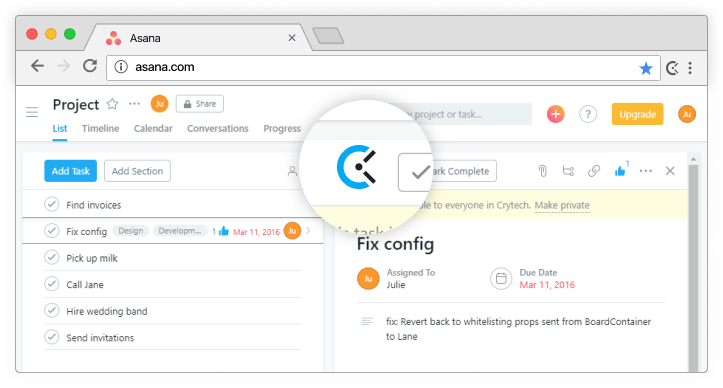
If you work with clients, you can send out detailed information about how and where you spent your time on projects.
Speaking of projects, imagine having to create a new layout for each project you take on. That probably takes away hours every week — of that 80-hour week.
But there’s a solution.
You can use Clockify to create templates from your existing projects if you have similar ones waiting in line. Here’s what it looks like on the time tracking platform:
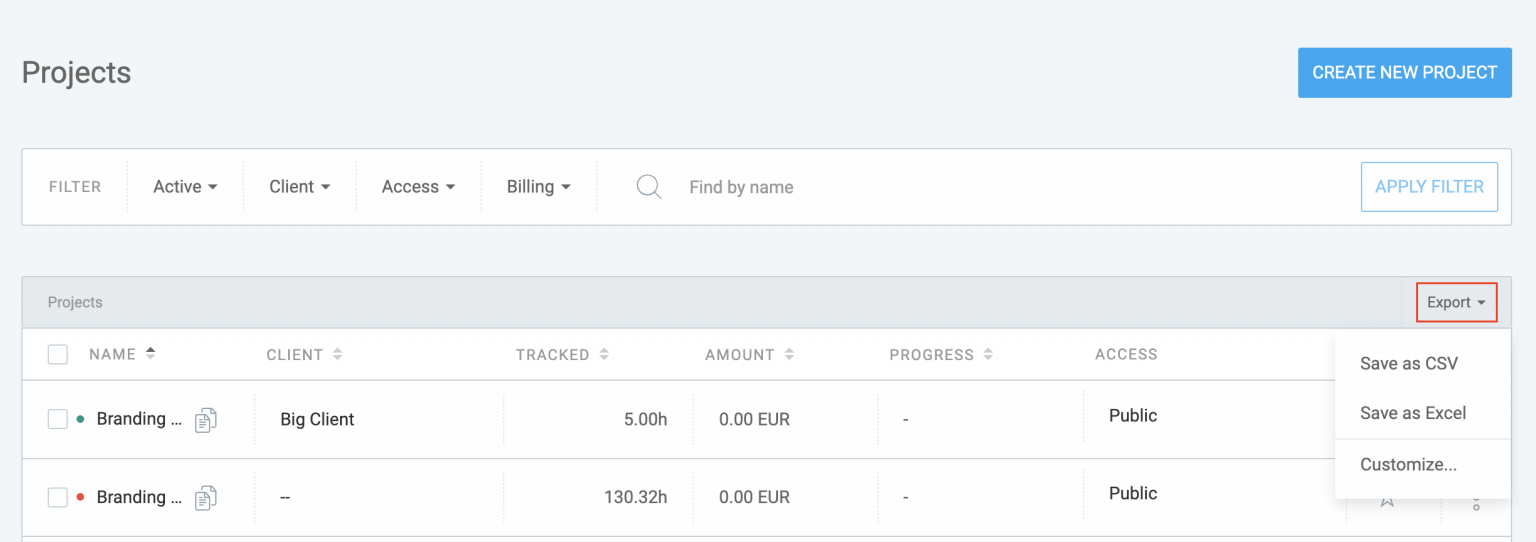
You could save a couple of hours per week of that total 80 by using Clockify’s Set as template option.
Your work is a masterpiece, and you don’t want to squander your precious time switching from app to app or creating new project layouts every time you onboard a new client.
Take the first step toward a more organized you.


